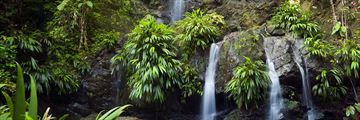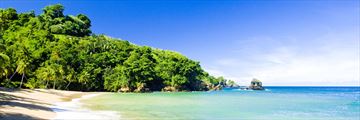Tobago, 26 miles of action, culture and mystery
If you are an active person planning a holiday in Tobago, and fearing you might be bored to tears after a couple of days on the beach, then think again. Although the island is just 26 miles long, it packs in some fascinating plantation history, cultural attractions, a couple of small museums, four forts, a heritage park, some stunning waterfalls and several other fascinating landmarks which I will mention further on. After all, I don’t want to give away all Tobago’s secrets in the first paragraph! In fact, Tobago has so many worthwhile attractions that many visitors pop across for the day from Trinidad, just to see them.

Tobago’s main industry in the past was sugarcane, and one of the remaining relics is the Arnos Vale Waterwheel to the southeast of Plymouth. The former sugarmill and surrounding land has been converted into a Heritage Park and the estate house is now a luxury hotel. The landmark waterwheel, originally built in Scotland and shipped to Tobago, remains in surprisingly good condition despite being well over 100 years old.
Once you’ve take a couple of photos, pop into the local museum onsite to learn more about Tobago’s sugar production, watch an informative presentation in the theatre, wander around the local nature reserve and enjoy a spot of birdwatching. Nearby you can visit the mystery tombstone near the Slave Village, and two original Amerindian sites. Lunch and drinks are served in the upmarket restaurant of the rum house, which has superb views from the veranda.
Despite being one of the most enchanting natural attractions on Tobago, the Rainbow Falls remain relatively quiet and unspoiled, mainly due to them being about 20 minutes’ walk along a winding trail from the Old Cocoa House of Hugh and Shirley McKenna. The falls have a pleasant white-water cascade of 328 feet, which splashes down the rock face to the Goldsborough River. The rising spray and mist create rainbows, hence the name.
Fort King George is one of Tobago’s main landmarks. Located on the hilltop overlooking the capital, Scarborough, it offers panoramic views. There is a National Fine Arts Centre in the former military hospital building and several crafts stalls nearby. The nearby Tobago Museum is in the former military hospital and has a fine collection of local artefacts, Amerindian relics, pottery, colonial treasures, maps, coins and even a skeleton.
Stroll around the beautifully landscaped gardens of Fort Bennett which is in Black Rock, just off Grafton Beach Road. It is easy to see why this point was chosen as a lookout point. The fortress was built in the late 18th century and there are battery remains, cannons and a pretty pavilion for a shady rest.
Take a boat ride across Courland Bay to get the best views of another military stronghold - Fort James. The fort was built in the early 19th century alongside the well-established barracks.
Fort Milford, at Crown Point, is on the south coast of Tobago. All that remains of this 18th century fortification are the walls and some very large cannons, but what you can see suggests it was a grand and impressive edifice in its heyday. Nowadays, most visitors come to stroll around the peaceful gardens, which are well maintained, and enjoy the tranquillity and views.
After viewing all these forts, you may wonder which is the oldest. In fact, the Courland Monument marks the site of the oldest fort, built by settlers in the 17th century, next to the church. The monument was erected in 1978 and is named after the Duke of Courland, who was largely responsible for settling the island in the late 17th century.
Further reading: If you're looking to learn about the best activities and locations that you'll find when you arrive then check out the top 10 things to do in Tobago.
More Inspiration
Recommended holidays











